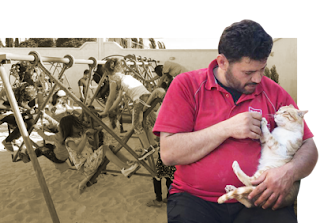With the Easter holidays approaching, research suggests that five out of six dog owners will take along their dog for a trip.
After multiple surveys by car manufacturers, veterinarians, and road safety bodies were conducted into the opinions of animal transportation, the findings were shocking. Car manufacturer Ford, for example, revealed that 32% of dog-owning drivers admitted to not securing their pets safely whilst driving. Whether they know it or not, this action puts themselves, passengers and other road users at risk. If you’re bringing home a new furry family member, or going away for a spring break, how do you ensure your pet's safety in transit?

According to the Highway Code, not restraining animals in a car could result in the driver being pulled over for driving without due care and attention, as they should “make sure dogs or other animals are suitably restrained, so they cannot distract you while you are driving or injure you, or themselves, if you stop quickly.” And, there’s a solution to every size and shape of pet; “a seat belt harness, pet carrier, dog cage or dog guard are ways of restraining animals in cars.”
Not only is allowing your unrestrained pet to be a distraction against the law, they could cause harm to themselves, other passengers or the driver, and could even potentially invalidate your car and pet insurance.
In another survey, owners also revealed some of the reasons behind not securing their pets. 32% of those questioned said it was because the animals didn’t like it, 31% claimed there was no need when undertaking short journeys, and 14% said they did not have room for a dog crate. If you want to take the guesswork out of deciding which method is best for your pet before you invest in a carrier or safety restraint,
take a look at our book, Dogs on Wheels (also available as an eBook.)
 So, if you’re planning to take your furry friend on a car journey (whether it be a short or long trip), check out these suggestions to make the experience more enjoyable for everyone involved:
So, if you’re planning to take your furry friend on a car journey (whether it be a short or long trip), check out these suggestions to make the experience more enjoyable for everyone involved:
1. Make sure that your vehicle is kitted out with either a sufficiently sized carrier, or a lead restraint. Don’t try and make do with a cardboard box, as anything that is not secure could lead to your pet escaping and dangerously distracting the driver.
2. If your pet is new to you, or has been displaying anxious behaviour, introduce them to the crate or car space in which they will be travelling at home, to allow them to acclimatise. Being suddenly confined to an unfamiliar, sometimes disorienting setting can be stressful, especially as your pet’s natural instinct is to want to see what’s going on! Furnish their area with a few familiar toys and bedding to provide a calm environment.
3. Don’t change their diet, or feed them right before setting off. A sudden switch in your pet’s food before the journey can upset them (and their stomach!) and that’s not what you want when you’re in the car together.
 4. Try to avoid feeding your pet right before you leave and when you’re on the road, but do keep a supply of their favourite biscuits or treats. Schedule in stops on your journey, for toilet breaks and fresh air. Never let dogs off the lead in a car park or motorway service area.
4. Try to avoid feeding your pet right before you leave and when you’re on the road, but do keep a supply of their favourite biscuits or treats. Schedule in stops on your journey, for toilet breaks and fresh air. Never let dogs off the lead in a car park or motorway service area.
5. Be aware that breeds with short noses (brachycephalic) can overheat faster than other breeds.
6. Clip claws to prevent a potential injury if your pet scratches in the carrier.
7. As always, take water and a bowl with you to keep your favourite companion well hydrated. The Highway Code recommends you always carry a large water bottle (5 litres minimum) in case your pet overheats, and needs to be rapidly cooled in an emergency.
 8. Cover your seats in doggie-durable, waterproof covers: saves wear and tear of the car and means less cleaning.
8. Cover your seats in doggie-durable, waterproof covers: saves wear and tear of the car and means less cleaning.
9. Leaving your pet alone in the car, no matter what the temperature might feel like outside, is a big NO!
The general advice is to keep your pets out of the front seat and off your lap, regardless of how short the journey is. Even the most docile pet could distract you at a safety-critical moment. You never know when they might react to something that they think is interesting outside the car. Don’t ruin your Easter holiday by letting your pet stick their head out of the window; as much as they may enjoy the breeze, it isn’t worth the risks involved!
As well has preventing a distraction from driving, restraining your dog will keep them away from dangerous holiday goodies that, in the body of a dog, become lethal, such as chocolate, and sweets containing the sweetener xylitol. If you feel like treating your beloved pet to a treat of their own, check out Doggie Cookies (also available as an eBook.)








